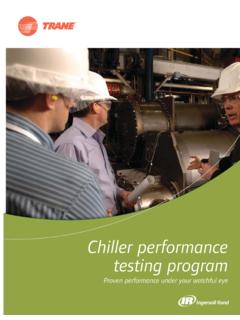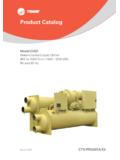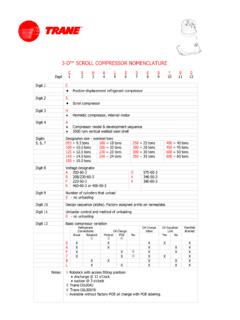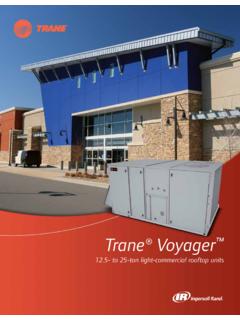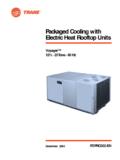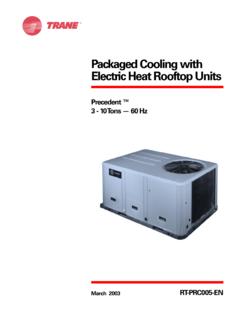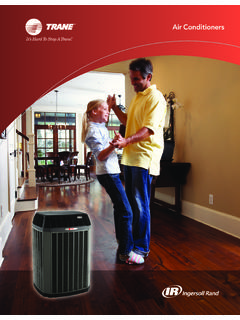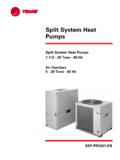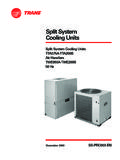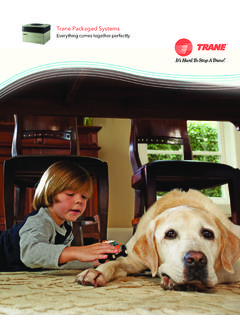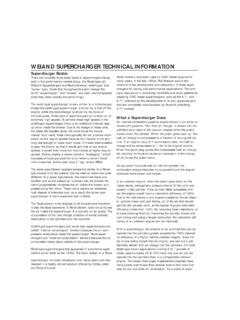Transcription of 100 Years of Trane History
1 Engineers Newsletterproviding insights for today s hvac system designer 2013 Trane , a business of Ingersoll Rand. All rights reserved. 1volume 42 1100 Years of Trane History An Applications Engineering PerspectiveThe formative yearsReuben Trane worked for his father as a plumber's helper for a year after graduation from high school in 1905, earning enough money to fund his engineering education at the University of Wisconsin. Upon graduation with a Bachelor of Science degree in mechanical engineering in 1910, Reuben first worked for three Years as a sales engineer with a Milwaukee machine tools firm before returning to La Crosse in 1913. That same year, Reuben, along with his sister Stella and his father, incorporated The Trane Co. to manufacture steam valve traps that James A. Trane had invented in connection with a vapor heating system. Initially, the business included contracting, as well as manufacturing and sales of heating specialties, and the design and distribution of Trane heating systems.
2 The primary products of the decade included vapor heating products, steam heating specialties, the direct return trap patented by Reuben in 1917, and a condensation pump line in 1917, Emil H. Erickson joined The Trane Co. from the Ford Motor Co. and persuaded Reuben Trane to focus on equipment manufacturing. The company discontinued its contracting business to concentrate on heating systems and specialties. In 1918 Erickson was asked to oversee the new 5,000-square-foot manufacturing operation. It was noted that Erickson dug into his own pocket to help purchase the first machines for the new plant. 1920s: Growth, innovation and seminal tenets Frank Hood, Reuben's brother-in-law, joined the company in 1920. During this decade, the direction of the company was shaped by ideas, inventions, and business strategy. The year 1925 exemplified this and was pivotal for two reasons one product focused and the other business inspired.
3 Reuben wanted to design a heating unit that could replace and improve upon the cast iron radiator. Realizing the need for a lighter material and better heat conductivity, he turned to copper. Using this new material, he created a new finned-tube design that would become today's ubiquitous coil. Once the coil design was complete, he turned his attention to a new cabinet. The cabinet was specifically designed to circulate air without a fan using the properties of natural convection. This seemingly simple change transformed the industry, but not immediately. Two daunting factors had to be overcome: manufacturing and 1864, a young James A. Trane immigrated from Norway to La Crosse, Wis., with his parents. He married Mary Miller in 1880 and opened a plumbing and heating shop on Pearl Street in 1885. On Sept. 13, 1886, his son Reuben was 1. James A. and Reuben TraneThe Trane Engineers Newsletter has been providing insight into HVAC system design for more than 40 Years .
4 This issue is quite different from our typical technical focus. As Trane begins its second century of operation as a company, Applications Engineering wanted to look back at the first 100 Years and share some technology highlights with you. The research helped us understand how Trane worked with our readers consulting engineers, design-build contractors, and technical owners to develop, refine and offer various systems throughout the Years . We hope you find it interesting and invite you to join in the anniversary celebration. 2 Trane Engineers Newsletter volume 42 1providing insights for today s HVAC system designerManufacturing. The Trane Co. did not have the manufacturing facilities to build the entire unit, and cast iron radiator manufacturers were not interested in manufacturing a product that could replace their primary business.
5 This led to The Trane Co. building the cabinetry and working with partners to manufacture the heating element. Distribution. Due to the convector s appealing aesthetics, a major proponent of the convector was the architectural community. Up until this time, the majority of business was sold through wholesalers. However, the demand for a variety of cabinet types and colors was not conducive to wholesaler stocking methods. It became evident that another distribution method would be needed to successfully sell in the address the demand, in 1925 the first Trane assistant branch office manager class convened. It was comprised of 16 young men who were trained in La Crosse. The graduates would become assistants to those already functioning as field manufacturer's agents, or managers for the larger Trane wholesaler customers. This program evolved into the industry renowned Trane Graduate Training Program, which is still going strong patent for the convector was filed in April of 1926, and the first was installed in the residence of Humrick, the Trane Des Moines, Iowa, office manager on Oct.
6 28, 1926. Combined with steam heating specialties and pumps, Trane furnished both the units and all system components. The first of the allied products combined a horizontal propeller fan with a square coil. Realizing the need to manufacture the new convector completely in-house, manufacturing was expanded. A second factory would be built in La : Expansion, education and developmentThe Trane cooling coil the core of Trane air conditioners was invented in 1931. Reuben Trane and engineer Reuben Anderegg investigated using a fan coupled with cold water running through a convector coil for comfort cooling. A well was drilled on the property and cold ground water was pumped through the coil. In 1931 the first Trane cooling coil was installed at the Indiana Theater in Indianapolis and a similar unit in the Realto Theater in Louisville, Ky. The Great Depression did not significantly affect Trane business until 1932, at which point more man-hours were invested in researching new applications.
7 This was the year that the term Climate Changer was used for the first time applied to an oil burning included strainers on the aircraft carrier USS Yorktown, railroad air conditioners, unit heaters and ventilators and many other specialties. By 1935 Trane offered direct-expansion cooling coils that permitted air conditioning to be installed in locations where cold water was not available, such as Houston. In 1936 variable-speed, direct-current motors allowed unit heater fans to be operated at five different speeds so the recent advent of variable-air-volume terminal units should not be a surprise! TurboVac product launch. In 1938, during its 25th anniversary, The Trane Co. announced the TurboVac chiller design a semi-hermetic, direct-drive, low pressure (in a vacuum) centrifugal chiller (Figure 3). Its packaging, simplicity (compared to field-erected chillers), and reliability helped Trane become an air-conditioning industry leader.
8 The simplicity and reliability of centrifugal chiller design became a company tenet. The arrival of the TurboVac was huge, and it deserved a marketing plan equal in scope. 1To nationally market the new chiller, Trane sponsored the greatest golf marathon in History , chronicled in King of Clubs. Traveling in The Trane of the Air DC-3 Skysleeper, Reuben accompanied golfer J. Smith Ferebee to eight different cities coast-to-coast in just four days! While Ferebee golfed 600 holes, Reuben Trane met with engineers and architects in each city to help them understand how the TurboVac chiller would improve building air products. To provide support and expand the technical content of Trane educational offerings, the company hired William Goodman, an eminent air-conditioning consulting engineer. Under his guidance, after three Years of development and an investment of $40,000, Trane published its 325-page Air Conditioning Manual in 1938 and sold copies for $5.
9 In 1936 Trane offered a psychrometric chart and the Trane Air Conditioning Ruler for a dollar. Weather Magic debuted in 1937, a periodical written for architects, engineers, contractors and select industrials. In later Years Weather Magic evolved into a broader marketing changes. On Jan. 24, 1936, the first generation of the company, James Trane , passed away. Emil Erickson assumed his position and Donald C. Minard, a member of the 1925 student class, became a vice president. As with all companies, entry into World War II led to the departure of many of the young men on The Trane Co. roster to the services and also changed the direction of the 2. Members of the first Trane assistant branch office manager classFigure 3. Reuben Trane and the TurboVac1 The King of Clubs by Jim Ducibella, insights for today s HVAC system designerTrane Engineers Newsletter volume 42 1 31940s: A change of focus, and base product improvementsWorld War II forced many manufacturing firms, including The Trane Co.
10 , to change their focus from consumer and business products to manufacturing processes to support military production. The Trane Co. leaders and engineers subsequently found that with slight modifications, some of their heating and cooling equipment was well-suited for process work. For example, an evaporative condensing unit was modified to cool quenching oil, a process used in small arms ammunition examining business opportunities, Trane learned that the military required a rather unusual heat exchanger. An airplane needed to cool air from its supercharger by using outside air. American planes were designed to perform best at sea level with 90 degrees F temperature conditions for pressure. At altitude, performance was lost, putting pilots and missions at risk. While the supercharger could establish the proper pressure, in doing so a great deal of heat had to be transferred through a heat exchanger (intercooler). The initial design using copper and a cement-like material to stick heat exchanger plates together was unsuccessful due to the pressures turned to brazing aluminum as a possible solution something that had not been done before.
